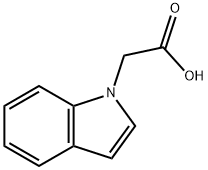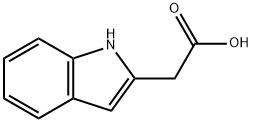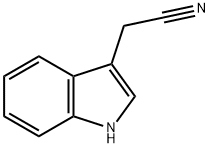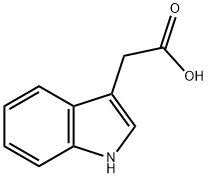Indol-1-yl-acetic acid
- CAS NO.:24297-59-4
- Empirical Formula: C10H9NO2
- Molecular Weight: 175.18
- MDL number: MFCD00047262
- EINECS: 200-589-5
- SAFETY DATA SHEET (SDS)
- Update Date: 2023-04-23 13:52:06

What is Indol-1-yl-acetic acid?
The Uses of Indol-1-yl-acetic acid
Indol-1-yl-acetic Acid is a reactant used in the preparation of conformationally restrained analogs of pravadoline; nanomolar potent, enantioselective, (aminoalkyl)?indole agonists of the cannabinoid receptor.
Definition
ChEBI: An indolyl carboxylic acid that is acetic acid in which one of the methyl hydrogens is substituted by an indol-1-yl group.
Properties of Indol-1-yl-acetic acid
| Melting point: | 168.0 to 172.0 °C |
| Boiling point: | 384.5±25.0 °C(Predicted) |
| Density | 1.23±0.1 g/cm3(Predicted) |
| storage temp. | Sealed in dry,Room Temperature |
| solubility | Acetone (Slightly), DMSO (Slightly), Methanol (Slightly) |
| form | Solid |
| pka | 4.31±0.10(Predicted) |
| color | Light Orange to Dark Orange |
| CAS DataBase Reference | 24297-59-4(CAS DataBase Reference) |
Safety information for Indol-1-yl-acetic acid
| Signal word | Warning |
| Pictogram(s) |
 Corrosion Corrosives GHS05  Exclamation Mark Irritant GHS07 |
| GHS Hazard Statements |
H302:Acute toxicity,oral H318:Serious eye damage/eye irritation |
| Precautionary Statement Codes |
P264:Wash hands thoroughly after handling. P264:Wash skin thouroughly after handling. P305+P351+P338:IF IN EYES: Rinse cautiously with water for several minutes. Remove contact lenses, if present and easy to do. Continuerinsing. |
Computed Descriptors for Indol-1-yl-acetic acid
New Products
4-Fluorophenylacetic acid 4-Methylphenylacetic acid N-Boc-D-alaninol N-BOC-D/L-ALANINOL Tert-butyl bis(2-chloroethyl)carbamate 3-Morpholino-1-(4-nitrophenyl)-5,6-dihydropyridin- 2(1H)-one Furan-2,5-Dicarboxylic Acid Tropic acid S-2-CHLORO PROPIONIC ACID ETHYL ISOCYANOACETATE 2-Bromo-1,3-Bis(Dimethylamino)Trimethinium Hexafluorophosphate (6-METHYL-[1,3]DITHIOLO[4,5-b]QUINOXALIN-2-ONE INDAZOLE-3-CARBOXYLIC ACID 4-IODO BENZOIC ACID (2-Hydroxyphenyl)acetonitrile 4-Bromopyrazole 5,6-Dimethoxyindanone 2-(Cyanocyclohexyl)acetic acid 4-methoxy-3,5-dinitropyridine 2-aminopropyl benzoate hydrochloride 1-(4-(aminomethyl)benzyl)urea hydrochloride diethyl 2-(2-((tertbutoxycarbonyl)amino) ethyl)malonate tert-butyl 4- (ureidomethyl)benzylcarbamate Ethyl-2-chloro((4-methoxyphenyl)hydrazono)acetateRelated products of tetrahydrofuran








You may like
-
 (1-Indolyl)acetic Acid CAS 24297-59-4View Details
(1-Indolyl)acetic Acid CAS 24297-59-4View Details
24297-59-4 -
 Indol-1-yl-acetic acid 96% CAS 24297-59-4View Details
Indol-1-yl-acetic acid 96% CAS 24297-59-4View Details
24297-59-4 -
 1-INDOLEACETIC ACID CAS 24297-59-4View Details
1-INDOLEACETIC ACID CAS 24297-59-4View Details
24297-59-4 -
 1975-50-4 98%View Details
1975-50-4 98%View Details
1975-50-4 -
 2-HYDROXY BENZYL ALCOHOL 98%View Details
2-HYDROXY BENZYL ALCOHOL 98%View Details
90-01-7 -
 2-Chloro-1,3-Bis(Dimethylamino)Trimethinium Hexafluorophosphate 221615-75-4 98%View Details
2-Chloro-1,3-Bis(Dimethylamino)Trimethinium Hexafluorophosphate 221615-75-4 98%View Details
221615-75-4 -
 14714-50-2 (2-Hydroxyphenyl)acetonitrile 98+View Details
14714-50-2 (2-Hydroxyphenyl)acetonitrile 98+View Details
14714-50-2 -
 118753-70-1 98+View Details
118753-70-1 98+View Details
118753-70-1
Statement: All products displayed on this website are only used for non medical purposes such as industrial applications or scientific research, and cannot be used for clinical diagnosis or treatment of humans or animals. They are not medicinal or edible.